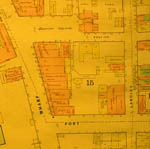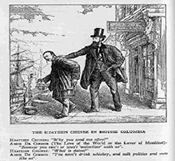 |
 |
 |
 |
 |
 |
 |
Victoria was a town of aliens and immigrants. Racism was dealt freely not only to the Native inhabitants but others of different creed and colour as well. African Americans, Chinese, Eastern Europeans, Japanese, and the Hawaiian “Kanaka”, were all groups who experienced the racism of the white settler and his administration. For specific reasons both the Chinese and Blacks were persecuted in particular; the Chinese were numerous enough to threaten the white labour force and the blacks sought refuge from American persecution only to find their refuge overrun by the very Americans they were running from. The ‘Chinese question’, as the local newspapers referred it to, argued the degrading impact of the ‘Chinaman’ on Victorian society. In reaction to public despair, a commission was created to investigate the Chinese and their effect on society. Amor De Cosmos, newspaper editor of the British colonist, was a known anti-Chinese activist and represented much of the settler population. His newspaper was a known advocate of the settler anti-Chinese sentiment and dealt often with the notion of ‘social statesmanship’, a responsibility of white settlers for white settlers. The British Colonist presented their argument for the banning of the Chinese labourer through statements such as these: "The Chinaman’s “tendency
is to degrade labor and lessen the opportunities of employment”
To further illustrate the mood of the day
through Amor De Cosmos, one of the leading men of the anti-Chinese
movement, Because they were less in number and of the same creed, African Americans were not as formally discriminated against as the Chinese however an anti-black sentiment held firm ground. With much American influence, Victorian society was segregated with one African American remarking; “All the hotels, Inns, and whiskey shops are closed against us, and a coloured gentlemen was ordered out of the cabin of the steamer Gov. Douglas, the other day”. Not only were business restricted from the Black community but some settlers believed the church should be as well. In support of segregation, one white settler even offered to build a separate gallery of the English Church for a fee of $500. Despite the African Americans holding the same rights in law, they did not hold the same rights in society. The Black community felt this contradiction within Victorian society with an overbearing strength and felt disheartened by the discrepancy of British law and social sentiment. Because of the degrading situation the Blacks faced in the United States, mass meeting were held to discuss the question as to where they could go to escape this prejudice. Many concluded to go to Vancouver Island where it was expected they would find a welcoming hand if not an accepting one. On June 10, 1859 a letter was written to the Editor of a local Newspaper by one of those who decided to escape to Vancouver Island. The first paragraph reads: “have the coloured people realized their fond anticipations in coming to Vancouver’s Island? I answer no. And if not, what is the position they occupy in this colony? I answer decidedly a degrading one, and certainly one not to be borne by men of spirit.” The articulate author writes on to say that they came, they saw, and they conquered difficulties, but that they have not conquered the prejudice that their enemies hold on to so tightly. With a “friendly feeling” towards the British government for its liberal policy towards the men of colour, many blacks expected a safe haven when arriving in the British colony as they were considered equal in law. The anonymous authour writes to this that: “some of our people whose susceptibilities are not so keen upon the subject of human rights say that having the law in our favor we ask no more. It is well said, if ‘ignorance is bliss’. But when I consider how many ways there are to evade the law, I subscribe to no such doctrine, for there is a power behind the throne stronger than the throne itself and that power is public opinion.” (British Colonist, June 10, 1859) As we can see through the experiences of this member of the black community, a large gap lay between the British theory of every man being equal before the law and social norms of the British colony. Although recognition of equality by law was a step in the right direction, on a societal level, equality was whitewashed in opposition to racism. Vancouver Island and the later created colony of British Columbia have histories fraught with racial tensions and prejudice. As many conclude Canada’s racial history to be tolerant and accepting when compared to that of the United States, we only have to look as far as the experiences as those who were of a minority in the British colony. The differences between the two countries lay not in tolerance but in methods of racist application. Where as the United States has a history of overt racism, British colonies such as Vancouver Island applied racism in an institutionalized manner where violence took a back seat to discrimination. --------------------------------------------------------------------------------------------------------------------- Documents --------------------------------------------------------------------------------------------------------------------- | |
